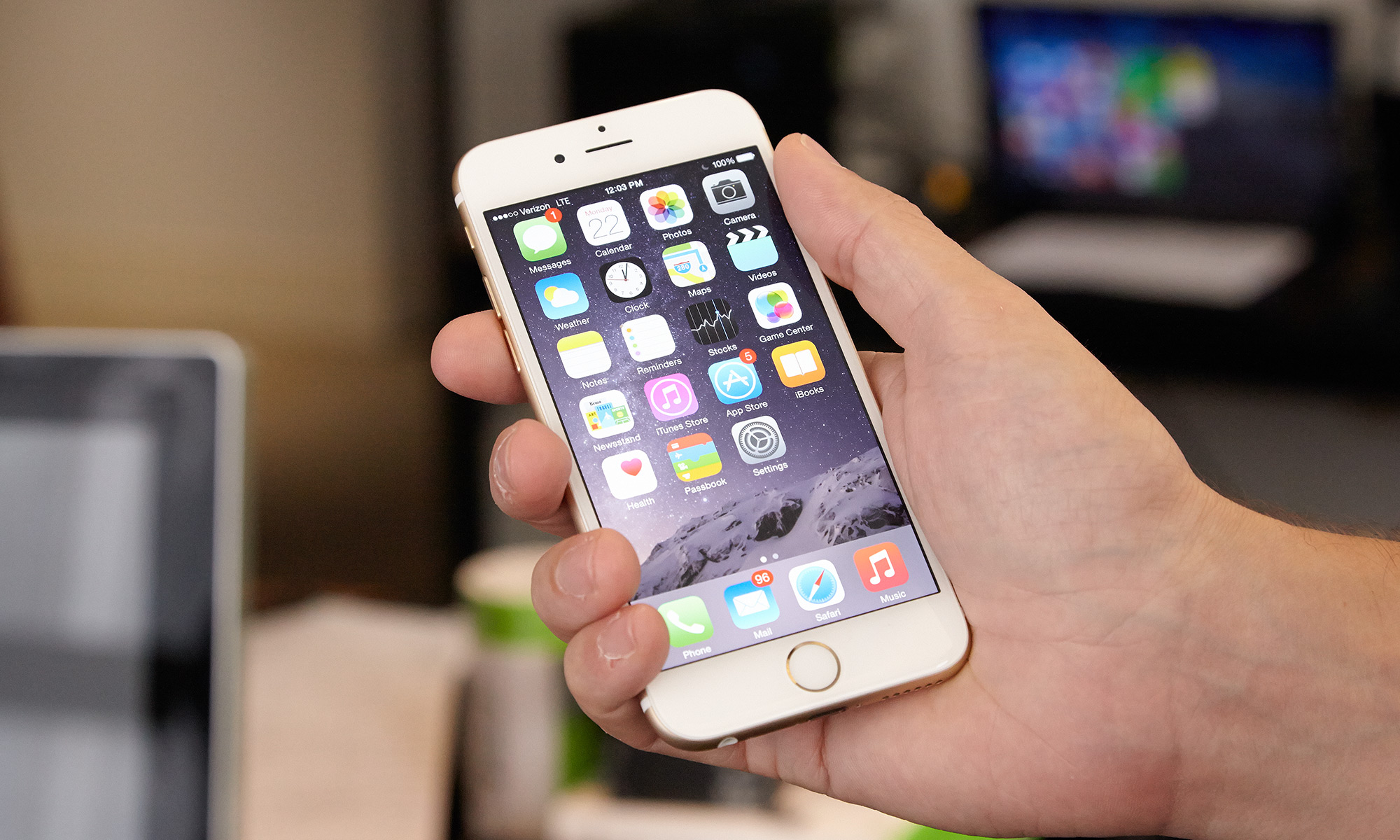Tom's Guide Verdict
The iPhone 6's elegant design, crisp display and speedy processor make it the best iPhone yet.
Pros
- +
Sleek, lightweight design
- +
Crisp Retina display
- +
Fast A8 processor
- +
Sharp iSight camera
Cons
- -
Below-average battery life
- -
Minor camera software issues
- -
Screen not full HD
Why you can trust Tom's Guide
After years of subtle innovation, Apple is ready to make a statement with the iPhone 6. This 4.7-inch smartphone has stepped up in size to its Android rivals, with a sleek, rounded design that brings the iPhone gracefully into the realm of taller, wider handsets.
This flagship has more than just looks, though, with a beefy A8 processor and improved iSight camera that make playing games and taking photos a smoother experience than ever. Is the iPhone 6 the best smartphone on the market, or is Apple simply catching up to the competition?
Editors' note:Apple announced that the starting prices for the iPhone 6s and iPhone 6s Plus, due out Sept. 25, will be $199 and $299, respectively (with a two-year contract). Both phones will feature an upgraded 12-megapixel camera, a faster processor and a new 3D Touch haptic feedback display.
Design
Coming from my measly, now-ancient iPhone 4s, the iPhone 6 is the thinner, bigger iPhone I've been yearning for. It's the slimmest and curviest iPhone yet, with rounded edges that are more reminiscent of an iPad Air than the more rectangular sides found on the previous few iPhone generations. With no sharp corners, the iPhone 6 is a joy to hold. However, the smooth sides and back make the device feel more slippery than I’d like.
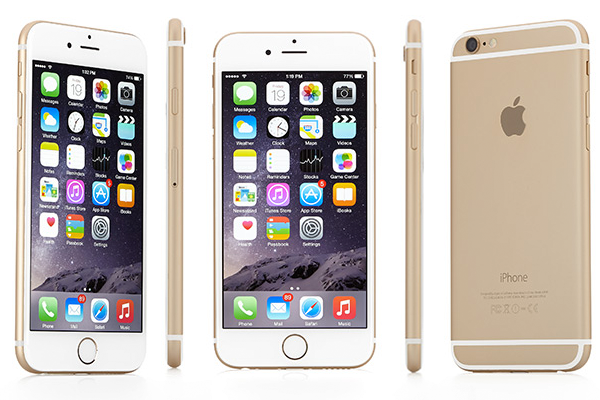
You'll quickly take note of the iPhone 6's 4.7-inch display (up from the 4-inch iPhone 5s), which is flanked by some barely there bezels on the left and right with a smooth Touch ID home button below. The new iPhone's volume and mute buttons assume their usual position on the device's left edge, while the power button has moved from the top edge to the right (this is a nice way to avoid accidental shutoffs in landscape mode).

The iPhone 6's matte back panel (available in silver, gold and space gray) is incredibly smooth to the touch, but also houses the device's very few design flaws. The HTC One-esque stripes that line the top and bottom of the panel look awkwardly un-Apple, and it may take a bit of time to get used to the handset's protruding 8-MP iSight camera.
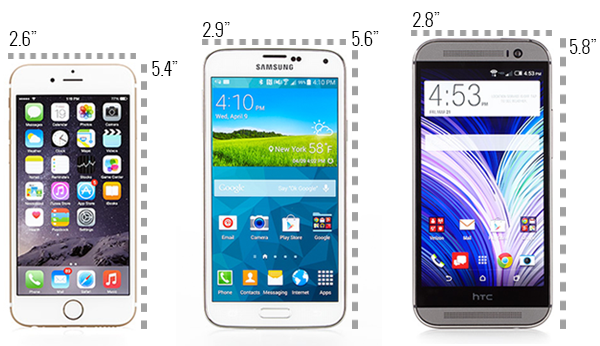
Measuring 5.4 x 2.6 x 0.27 inches, the iPhone 6 has finally entered the 4.7-inch-and-higher space dominated by phones like the Samsung Galaxy S5 and the HTC One M8. The 4.55-ounce iPhone 6 is the lightest and slimmest of the bunch, though the 5.1-ounce Galaxy S5 and 5.6-ounce HTC One M8 have bigger displays at 5 and 5.1 inches, respectively.
Display
The iPhone 6 hasn't quite made the jump to full HD like its Galaxy S5 and HTC One M8 rivals, but the device's 4.7-inch, 1334 x 750 Retina HD display is alluring nonetheless. The colorful array of default app icons that line the smartphone's home screen are bright and easy to make out, and image-heavy websites such as Tom's Guide look similarly vivid.
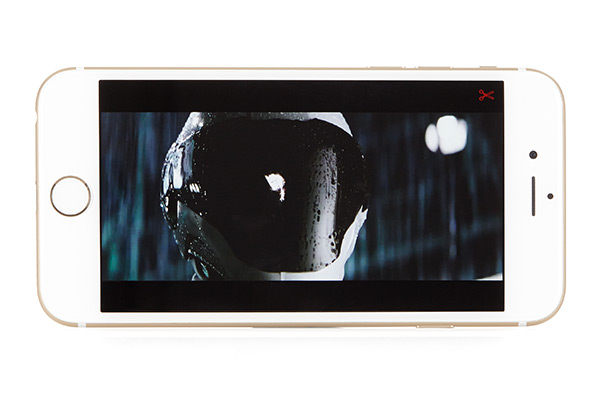
The HD trailer for The Hunger Games: Mockingjay was packed with detail on Apple's new phone, from Jennifer Lawrence's subtle freckles to Donald Sutherland's not-so-subtle wrinkles. The clip looked just slightly sharper on the full-HD Galaxy S5, but brighter on the iPhone 6, and the difference in detail is only noticeable if you pause the action and look extremely close.
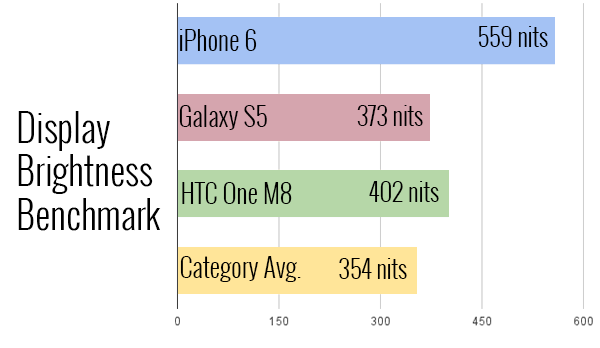
The iPhone 6's luminous display was equally impressive during our screen test, producing an average brightness of 559 nits. This beats out the Galaxy S5 and One M8, while also besting our 354-nit smartphone average.
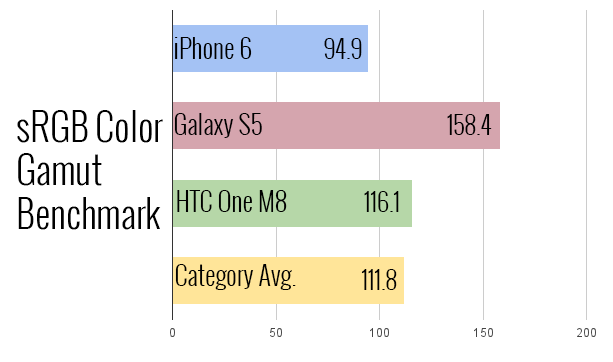
The new iPhone displayed a respectable 94.9 percent of the sRGB color gamut, which is less than the Galaxy S5 (156.3 percent) and One M8 (115 percent) but impressively close to 100 percent. The handset wasn't quite as spot on when it came to color accuracy, as its 3.0 Delta E rating (closer to 1 is better) beat out the One M8 (4.1) but didn't come as close as the Galaxy S5's 0.9
Audio
The iPhone 6's bottom-edged speaker delivered decently loud audio, though I had mixed results with quality.

The piercing vocals and guitars of Fall Out Boy's "Centuries" sounded satisfying, but drums and bass were thin. The auto-tuned vocals and subtle background pianos of Kanye West's "Blood on the Leaves" came through clearly on the iPhone 6, but the song's normally thumping horns sounded underwhelming once they entered the mix.
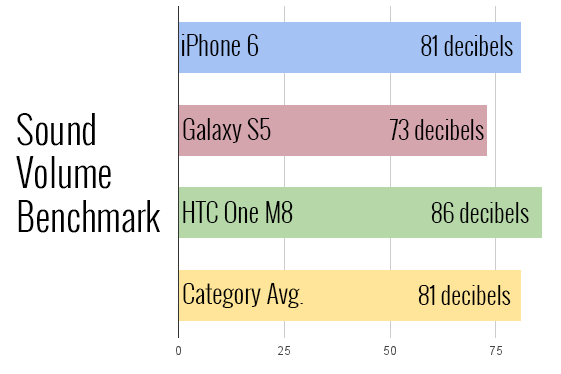
The iPhone 6's 81-decibel performance on our audio test proved louder than the Galaxy S5, though it fell behind the One M8's excellent BoomSound speakers.
Performance
Backed by Apple's new A8 processor, the iPhone 6 is the company's speediest smartphone yet. I've spent long hours streaming video and cranking music while quickly hopping from app to app, and the new iPhone has yet to show any signs of slowdown.

The iPhone 6's beefier CPU makes it a mobile gamer's dream. I had a blast playing console-quality games like Dead Trigger 2, Madden Mobile and Asphalt 8: Airborne, the latter of which benefits from extra-realistic lighting and effects, thanks to iOS 8's Metal graphics engine.
The smartphone is pretty quick to open those games, too. The iPhone 6 booted N.O.V.A 3 in a brisk 4.6 seconds, which is a fraction of the time it took for the Galaxy S5 (19 seconds) and the One M8 (17) to do the same task.
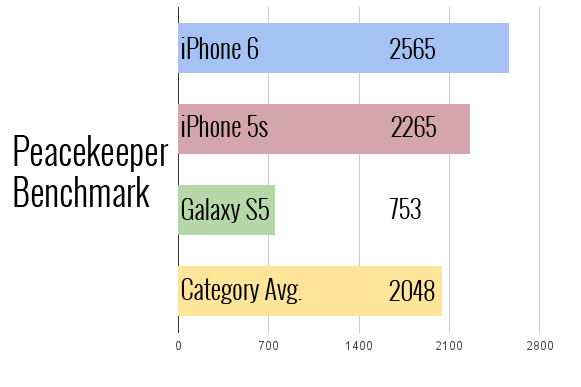
On Peacekeeper, which measures browser performance, the iPhone 6 notched 2,565. When we ran the test using Chrome on the S5, it scored a much lower 753.
Moving on to Geekbench 3, which measures multi-core performance, the iPhone 6's score of 2,931 beat out most of the competition.
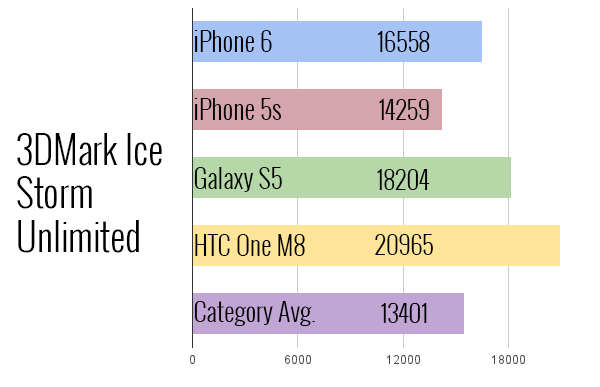
Apple's smartphone turned in mixed results on graphics tests. It posted 16,558 on the 3DMark Ice Storm Unlimited, falling behind both the One M8 and the Galaxy S5. However, on GFXBench Manhattan, which measures OpenGL ES 3.0 performance, the iPhone 6 hit 30.1 frames per second -- more than twice as fast as the S5.
Camera
Ever since I got my hands on an iPhone 6, I've taken way more slow-motion videos of my dog running around my apartment than I'm willing to admit. The iPhone's ability to capture slo-mo videos at up to 240 frames per second is one of several new enhancements to the phone's 8-MP iSight camera, which now packs Focus Pixels for extra-fast autofocus. The phone can also shoot standard 1080p video at up to 60 fps.
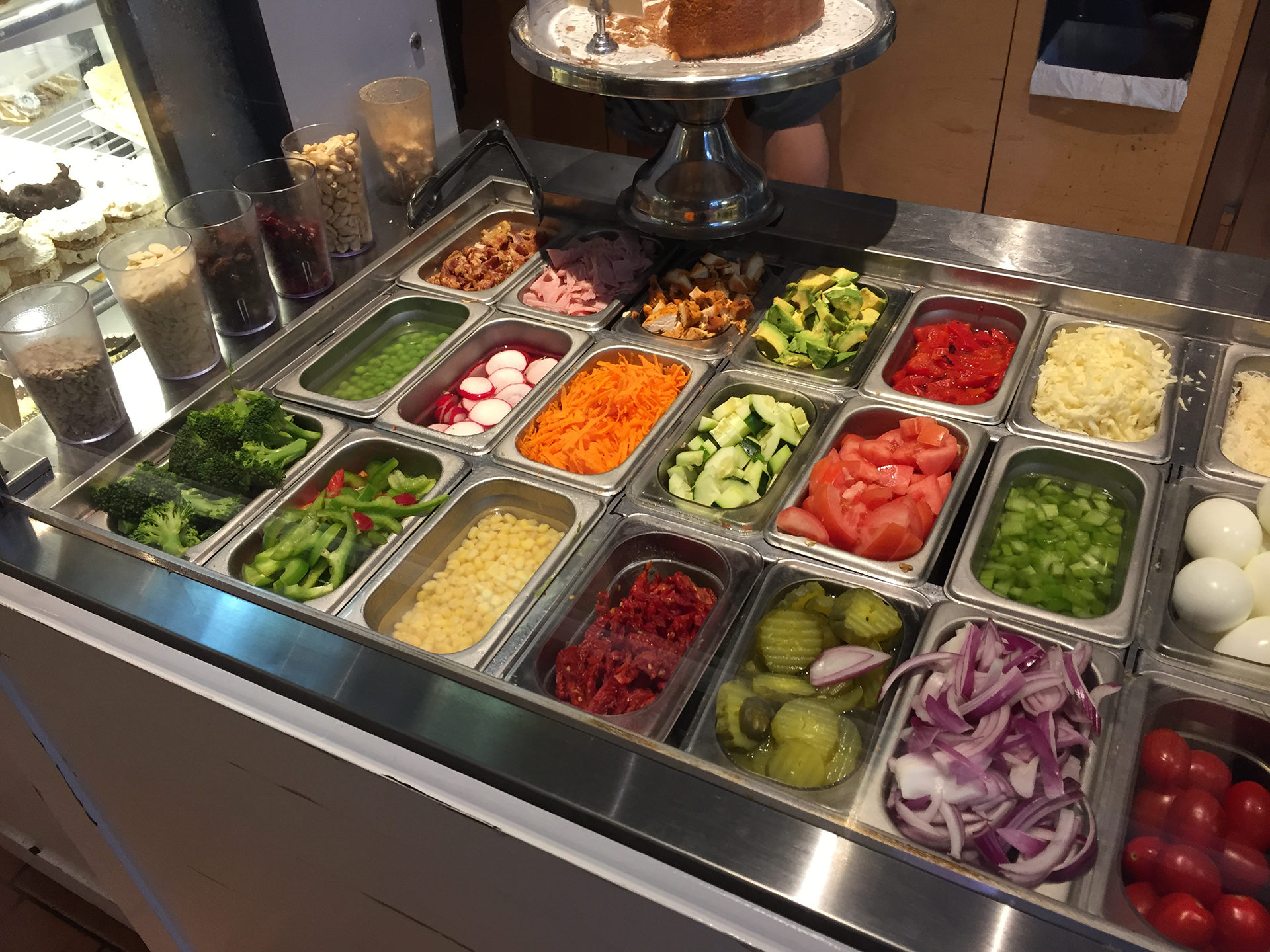
Most people use their iPhones for capturing quick stills of everyday life, and the iPhone 6 is as good a point-and-shoot replacement as Apple's ever made. From a close-up of a baby's face to a sunny landscape taken along a Bronx beachfront, just about every shot I took with the smartphone was packed with detail and rich in color.
A 1080p video I filmed in the middle of Union Square was similarly impressive. Pedestrians and vehicles moved fluidly, and the video was sharp enough for me to make out store logos and street signs.
While I generally was able to get great-looking pictures and videos out of the iPhone 6's camera, a recent test we performed revealed that iOS 8 is keeping the smartphone's sensor from producing the best shots possible. On both the iPhone 6 and 6 Plus, we noticed some strange instances of inconsistent white balance, which made red peppers look purple.
To make sure this wasn't just an iPhone 6 issue, we took a few comparison shots between an iPhone 5s running iOS 8 and another 5s running iOS 7. We had the same issues with the former 5s as we did with the 6, which leads us to believe that iOS 8 has a camera software issue that can hopefully be patched in the future.
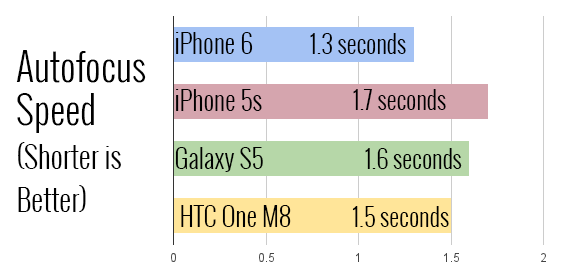
Thanks to Focus Pixels, the iPhone 6 was able to autofocus on the fine ridges of a plastic Spider-Man toy on my desk seemingly instantly. The iPhone 6 focused a bit faster than the iPhone 5s, Galaxy S5 and One M8, though the difference is hard to notice unless you've got a timer nearby.

The iPhone 6 retains the handset's reputation as an excellent selfie-taker, with an improved f/2.2 aperture over the iPhone 5s' f/2.4 aperture (this means better selfies in the dark.) When taking self-portraits under fluorescent office lighting, I was able to produce vibrant shots that retained finer details like facial stubble and the sleepy circles under my eyes. The selfies I took on a Galaxy S5 looked washed out and blurry by comparison.
iOS 8
The iPhone 6 ships with Apple's new iOS 8 operating system, which intros a few new apps while making some subtle UI and software compatibility features.
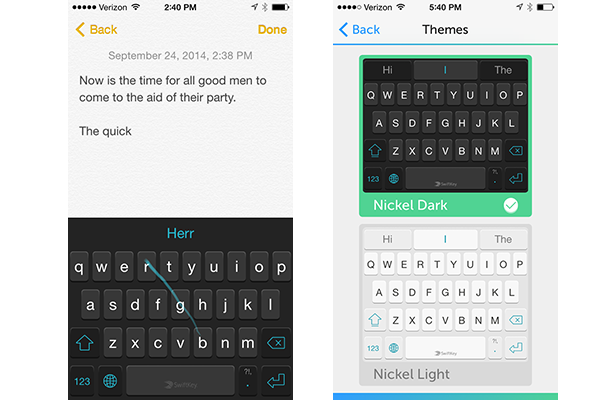
Touch-typing has been bolstered by a predictive text bar above the keyboard, which will keep track of your typing habits and try to finish your sentences accordingly. You can also swap in custom keyboards for the first time ever on an iPhone, with SwiftKey (pictured above), Swype and Fleksy among the first wave of alternative keyboards you can nab from the App Store.
Spotlight search has been beefed up to search the Web instead of just your device, and the software's multitasking mode now lets you quickly access your most recent contacts.
My favorite new software feature is Reachability, which is Apple's way of easing customers into the world of 4.7-inch and 5.5-inch phones. A gentle double-tap of the home button will bring the top half of the screen down to the bottom half, making apps like Safari and Mail much more friendly to your thumb.
MORE: See Our Full Review of iOS 8
Apple Health and Apple Pay
iOS 8 marks the debut of Health, which lets you log and view a wealth of information, including body mass, daily nutrition, exercise and sleep. The OS' fitness features will soon expand with HealthKit, which will funnel in data from Health as well as any third-party fitness apps you're using. There are already a handful of iOS 8-optimized Health apps currently on the App Store, including UP by Jawbone, FitStar Personal Trainer, WebMD and Map My Run+.
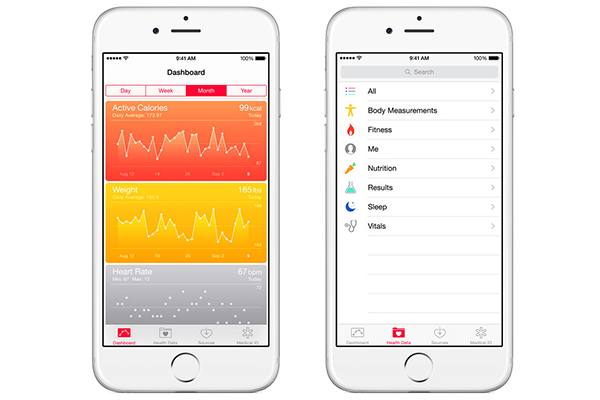
There's one other exciting iPhone 6 feature you can't quite use yet: Apple Pay. This mobile payment system will store your payment cards, using the iPhone 6 and 6 Plus' NFC capabilities to let you pay for products with a simple tap of your phone (and fingerprint verification) at any compatible point-of-sale system.
MORE: 15 Best iOS 8 Apps
While you'll have to wait a bit for HealthKit and Apple Pay, Apple's excellent iLife and iWork app suites are accessible on the iPhone 6 from the start. Between GarageBand, iMovie, Pages, Keynote and Numbers, there's plenty of ways to flex your creativity and productivity muscle.
Battery Life
The iPhone 6 held up for 7 hours and 40 minutes on our battery test, which consists of continuous Web surfing over AT&T's 4G LTE network at 150 nits (our Verizon iPhone 6 was a few minutes behind at 7:27).
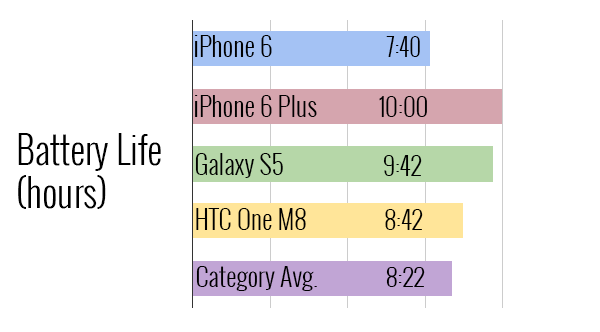
While the iPhone 6 might get you through most of a workday, the handset failed to outlive the Galaxy S5, One M8 or its iPhone 6 Plus counterpart, which endured an impressive 10 hours.
4G LTE Speeds
While the iPhone 6 itself is a zippy little machine, AT&T's 4G LTE speeds still aren't up to snuff in New York City. Using Speedtest.net in our Flatiron office, the device mustered download speeds of only 4.8 Mbps and average uploads of 0.35 Mbps. Performing the same test in Union Square gave us a similarly underwhelming average download speed of 2.82 Mbps, though average upload speeds shot up to 3 Mbps.
Surfing the Web in the office was even worse, with the ESPN and New York Times mobile sites taking 7 to 8 seconds to load and LaptopMag.com taking an excruciating 21 seconds. Things improved significantly when we moved down to Union Square, however, as ESPN.com and LaptopMag.com took 4 and 6 seconds to load, respectively.
This seems to strictly be a carrier issue, as our Verizon iPhone 6 averaged a zippy 20.3 Mbps download speed and 5.8 Mbps upload speed. On this version, websites rarely took more than 4 seconds to load.
6 or 6 Plus?
"To Plus or not to Plus?" is likely the question on many iPhone shoppers' minds, and the differences between the two phones go beyond mere screen size. If full HD is a must-have, the 6 Plus' 5.5-inch, 1920 x 1080 display has an edge over the iPhone 6's 4.7-inch, 1334 x 750 screen.
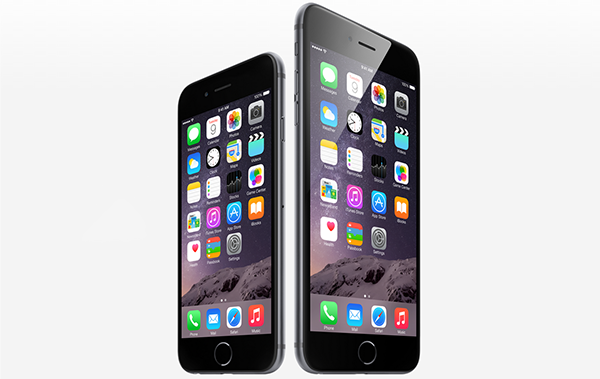
The bigger 6 Plus can also be used as an iPad Nano of sorts, as its exclusive dual-pane landscape mode lets you view your home screen horizontally and enjoy more real estate when texting and sending emails. Both devices boast the same crisp 8-MP iSight camera, but only the Plus has optical image stabilization for getting more solid shots in the dark.
You're getting the same speedy A8 processor with both phones, but the iPhone 6 Plus' 10-hour battery life is significantly better than the 7:40 we got out of the vanilla 6.
MORE: Best Smartphones on the Market Now
While the 6 Plus seems to be the clear winner in terms of performance, size is still a major concern. Phablet fanatics might not find anything wrong with the 6 Plus' massive frame, but, coming from a small handset like the 4s, I found the standard 6 far more comfy to hold.
The larger 6 Plus naturally packs a larger price tag, with a starting cost of $300 for a 16GB model compared with the 16GB iPhone 6's price of $200. If you can sacrifice size for storage space, the 64GB iPhone 6 costs just as much as a 16GB Plus.
Configurations
With a two-year contract, the iPhone 6 starts at $200 with 16GB of memory. You'll get four times the memory if you splurge for the $300, 64GB version, and can get 128GB if you shell out $400.
Bottom Line
The iPhone 6's best features are clear: it looks slick, feels great and performs gracefully. This A8-powered handset can handle any task you throw at it, and its crisp 4.7-inch Retina HD screen makes me glad Apple made the decision to finally go bigger. If you're an iPhone user who has always been jealous of the larger phones in your friends' pockets, this is the device for you.
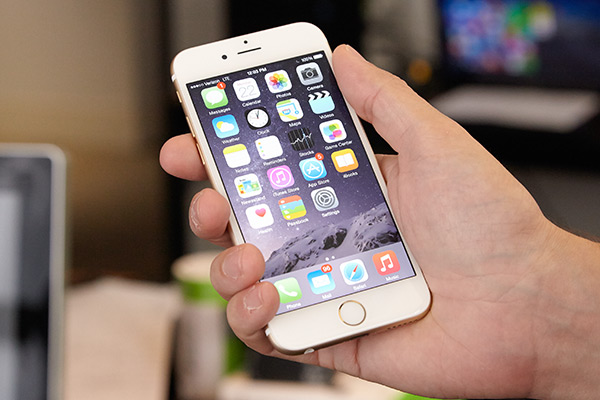
It isn't infallible, though. The iPhone 6's battery doesn't last quite as long as that of the Galaxy S5 and HTC One M8, and the handset lacks the full HD display of those two rivals as well as the 6 Plus. And while the phone's mostly excellent iSight camera is faster than ever thanks to Focus Pixels, a few iOS 8 issues keep it from being the best it can be -- at least for now.
The iPhone 6 might not be the perfect smartphone. But with a brilliantly light design, excellent app ecosystem and powerful overall performance, it's easily the best iPhone yet.
Mike Andronico is Senior Writer at CNNUnderscored. He was formerly Managing Editor at Tom's Guide, where he wrote extensively on gaming, as well as running the show on the news front. When not at work, you can usually catch him playing Street Fighter, devouring Twitch streams and trying to convince people that Hawkeye is the best Avenger.
-
dovah-chan I really like the quality of the front facing camera. I find this strange as I usually tend to automatically label Apple's cameras as not the best of the bunch (when I think of picture taken with iPhone I think of all that sound and graininess in their pictures) but the front facing camera surprised me. Either it was held really steadily or it has really good OIS. (which even my M8 doesn't have on its front cam) But I'm not pleased about a few things:Reply
-A8 is still dual core
-It still uses 1GB DDR3L RAM; the cost between 1GB and 2GB is like a dollar these days; there is no reason to continue using 1GB in this day and age
-Below average battery life with a lower resolution screen
Its easy to hate on a lower resolution screen but it could amount to longer battery life. But sadly, Apple hasn't taken advantage of it and has always failed to please in the battery department. The only thing keeping me from ever going into the Apple environment (well besides the iPad 2 that I haven't touched in over a year or two but is still somehow supported) is how closed in Apple is. I know its to have better control and prevent less malicious applications being installed on the users device but they're going out of control. -
Titillating To play devil's advocate, iPhones often manage to run quicker and smoother than a lot of Android phones with 3GB+ RAM. Obviously, it's a difference in architecture and the fact that Android uses Java, but it's still a point in Apple's favor. Of course, they could and should upgrade that to 2GB, but it works so far so it's hard to complain. Besides, knowing Apple, they'd probably tack on an extra $50 to the price tag for that 1GB upgrade :pReply -
house70 Apparently, from this article, the abysmal battery life is not due to the screen alone, as the lower resolution and the fact that the test was run at only 150 nits did not help with it. Other possible reasons could be poorly optimized antennas (see the low performance of LTE) or maybe the fact that the OS is still not capable of true multitasking. Maybe a combination of all the above.Reply
Fact is, despite the closed environment and the fact that they control both the hardware and the software, and they only have to optimize a handful of devices (all of which are their own), Apple is still trying to play catch up instead of leading the industry. Lack of innovation doesn't help, as pretty much all that's been touted as 'new' has already been available from other manufacturers for quite some time. -
kiniku I owned the first iPhone and years later I decided to give this 6th gen an honest try compared to years of owning Android flagships. This new iPhone was still an overall disappointment. The over-simplistic interface is still floating, square blobs that accumulate on the screen as you install apps. No shortcuts, no widgets. I don't want every single app I have installed bloated on the display.Reply
Battery life was a disappointment. With moderate use this phone can't hold a candle to the HTC One, S5 and G3's life.
Notifications: No LED indicator. You get this triple flash when someting comes in. You miss that and you are going tobe checking the phone with a pull down swipe. With Android I can color code notifications and it stays flashing until I respond. Bliss.
Browser: Still mostly locked in Safari. Email links and shortcuts will open with that default browser regardless if you have others like Chrome installed. I find it comical I that I could install Safari on Android. I wonder how many people do? :)
The 6 is a sleek phone. It has a very good speaker and bright display. But even years later it still has mostly the same limitations compared to Android. The blob interface is one that teenagers and grandparents will enjoy. -
Onus Does it have a user-replaceable battery? MicroSD expansion? The former in particular is an absolute dealbreaker.Reply
